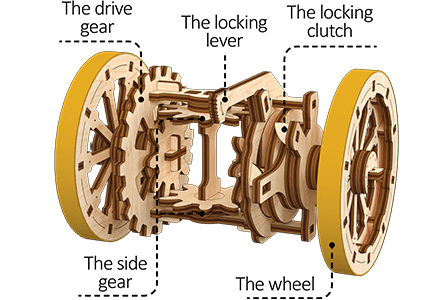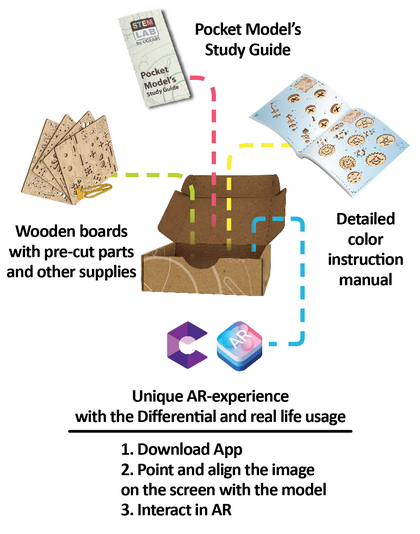Model Size: 6.9*5.3*4.1 in (17.5*13.5*10.5 cm)
Package size: 8.1*7.4*2.5 in (20.5*18.8*6.3 cm)
Number of components: 163
Estimated time of assembly: 1-2 hour

The Differential is a stylised educational model, an interactive study guide to the mechanism, only for learning its essentials and principles of working. The Differential was designed to ensure that the drive wheels sitting on the same axle rotate with a different rate and cover different distances at the same time. This mechanism allows the car to make turns without the wheels skidding, prevents wheel-slip, reduces tyre wear, and makes entering and going out of turns easier for the driver. Having assembled the Differential, you can unblock it pushing the lever in position 1 (Up) and set both wheels in motion by rotation of the drive gear or the wheel. The Control lever regulates the smooth locking of the left and right wheels independently by turning left or right respectively. In the “down” position of the lever, both wheels are linked in a rigid coupling and can either rotate together (propelled by the drive gear or a wheel) or lock simultaneously (by the lever of the wheel).
The car differential was invented by French engineer Onesiphore Pecqueur in 1825. In the 1930s of the 20th century, German automotive engineer Ferdinand Porsche made significant improvements to the device.
Differentials are used mainly in cars as a part of the transmission mechanism. They improve maneuvrability and performance of a car.
 |
The mechanism of the Differential is composed of:
|
The Differential is developed to serve as a learning tool rather than a puzzle.Just like the rest of Ugear’s collections, putting STEM-lab models together is fun and comprehensive: everything you need to build, learn, and discover comes in a box. There you will find:
|
 |
There are no reviews for this product.

Made from wood materials

The models produce motion

Assembling without glue and chemicals

Details are already cut and ready to assemble

Perfect for family projects through hands-on STEM learning